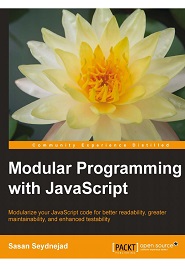
English | 2016 | ISBN: 978-1-78588-065-0 | 274 Pages | PDF, EPUB | 10 MB
Programming in the modular manner is always encouraged for bigger systems—it is easier to achieve scalability with modular programming. Even JavaScript developers are now interested in building programs in a modular pattern. Modules help people who aren’t yet familiar with code to find what they are looking for and also makes it easier for programmers to keep things that are related close together.
Designing and implementing applications in a modular manner is highly encouraged and desirable in both simple and enterprise level applications.
This book covers some real-life examples of modules and how we can translate that into our world of programming and application design. After getting an overview of JavaScript object-oriented programming (OOP) concepts and their practical usage, you should be able to write your own object definitions using the module pattern. You will then learn to design and augment modules and will explore the concepts of cloning, inheritance, sub-modules, and code extensibility. You will also learn about SandBoxing, application design, and architecture based on modular design concepts. Become familiar with AMD and CommonJS utilities.
By the end of the book, you will be able to build spectacular modular applications in JavaScript.
What You Will Learn
- Understand the important concepts of OOP in JavaScript, such as scope, objects, inheritance, event delegation, and more
- Find out how the module design pattern is used in OOP in JavaScript
- Design and augment modules using both tight augmentation and loose augmentation
- Extend the capabilities of modules by creating sub-modules using techniques such as cloning and inheritance
- Move from isolated module pieces to a cohesive, well integrated application modules that can interact and work together without being tightly coupled
- See how SandBoxing is used to create a medium for all the modules to talk to each other as well as to the core
- Use the concepts of modular application design to handle dependencies and load modules asynchronously
- Become familiar with AMD and CommonJS utilities and discover what the future of JavaScript holds for modular programming and architecture
If you are an intermediate to advanced JavaScript developer who has experience of writing JavaScript code but probably not in a modular, portable manner, or you are looking to develop enterprise level JavaScript applications, then this book is for you.
A basic understanding of JavaScript concepts such as OOP, prototypal inheritance, and closures is expected.
Resolve the captcha to access the links!